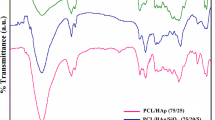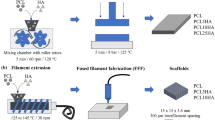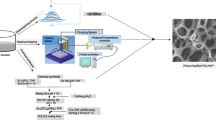Abstract
The design of bioactive scaffold materials able to guide cellular processes involved in new-tissue genesis is key determinant in bone tissue engineering. The aim of this study was the design and characterization of novel multi-phase biomaterials to be processed for the fabrication of 3D porous scaffolds able to provide a temporary biocompatible substrate for mesenchymal stem cells (MSCs) adhesion, proliferation and osteogenic differentiation. The biomaterials were prepared by blending poly(ε-caprolactone) (PCL) with thermoplastic zein (TZ), a thermoplastic material obtained by de novo thermoplasticization of zein. Furthermore, to bioactivate the scaffolds, microparticles of osteoconductive hydroxyapatite (HA) were dispersed within the organic phases. Results demonstrated that materials and formulations strongly affected the micro-structural properties and hydrophilicity of the scaffolds and, therefore, had a pivotal role in guiding cell/scaffold interaction. In particular, if compared to neat PCL, PCL–HA composite and PCL/TZ blend, the three-phase PCL/TZ–HA showed improved MSCs adhesion, proliferation and osteogenic differentiation capability, thus demonstrating potential for bone regeneration.








Similar content being viewed by others
References
Mercuri LG. Alloplastic temporomandibular joint reconstruction. Oral Surg Oral Med Oral Pathol Oral Radiol Endod. 1998;85:631–7.
Warnke PH, Springer ING, Wiltfang J, Acil Y, Eufinger H, Wehmöller M, Russo P, Bolte H, Sherry E, Behrens E. Growth and transplantation of a custom vascularised bone graft in a man. Lancet. 2004;364:766–70.
Salgado AJ, Coutinho OP, Reis RL. Bone tissue engineering: state of the art and future trends. Macromol Biosci. 2004;4:743–65.
Hutmacher DW. Scaffolds in tissue engineering bone and cartilage. Biomaterials. 2000;21:2529–43.
Eppley BL, Platis JM, Sadove AM. Experimental effects of bone plating in infancy on craniomaxillofacial skeletal growth. Cleft Palate Craniofac J. 1993;30:164–9.
Schantz JT, Teoh SH, Lim TC, Endres M, Lam CX, Hutmacher DW. Repair of calvarial defects with customized tissue-engineered bone grafts I. Evaluation of osteogenesis in a three-dimensional culture system. Tissue Eng. 2003;9:113–26.
Caplan AL. Adult mesenchymal stem cells for tissue engineering versus regenerative medicine. J Cell Physiol. 2007;213:341–7.
Kadiyala S, Jaiswal N, Bruder SP. Culture-expanded, bone marrow-derived mesenchymal stem cells can regenerate a critical-sized segmental bone defect. Tissue Eng. 1997;3:173–85.
Mygind T, Stiehler M, Baatrup A, Li H, Zou X, Flyvbjerg A, et al. Mesenchymal stem cell ingrowth and differentiation on coralline hydroxyapatite scaffolds. Biomaterials. 2007;28(6):1036–47.
Woodard JR, Hilldore AJ, Lan SK, Park CJ, Morgan AW, Eurell JAC, Clark SG, Wheeler MB, Jamison RD, Johnson AJW. The mechanical properties and osteoconductivity of hydroxyapatite bone scaffolds with multi-scale porosity. Biomaterials. 2007;28:45–54.
Ma PX, Zhang R, Xiao G, Franceschi R. Engineering new bone tissue in vitro on highly porous poly(a-hydroxyl acids)/hydroxyapatite composite scaffolds. J Biomed Mater Res. 2001;54:284–93.
Murugan R, Ramakrishna S. Development of nanocomposites for bone grafting. Compos Sci Technol. 2005;65:2385–406.
Shor L, Güçeri S, Wen X, Gandhi M, Sun W. Fabrication of three-dimensional polycaprolactone/hydroxyapatite tissue scaffolds and osteoblast–scaffold interactions in vitro. Biomaterials. 2007;28:5291–7.
Kim S, Ahn K, Park MS, Lee J, Choi CY, Kim B. A poly(lactide-co-glycolide)/hydroxyapatite composite scaffold with enhanced osteoconductivity. J Biomed Mater Res. 2007;80A:206–15.
Ciardelli G, Chiono V, Vozzi G, Pracella M, Ahluwalia A, Barbani N, et al. Blends of poly-(ε-caprolactone) and polysaccharides in tissue engineering applications. Biomacromolecules. 2005;6:1961–76.
Di Franco CR, Cyras VP, Busalmen JP, Ruseckaite RA, Vázquez A. Degradation of polycaprolactone/starch blends and composites with sisal fibre. Polym Degrad Stab. 2004;86:95–103.
Dong J, Sun Q, Wang J. Basic study of corn protein, zein, as a biomaterial in tissue engineering, surface morphology and biocompatibility. Biomaterials. 2004;25:4691–7.
Gong S, Wang H, Sun Q, Xue S, Wang J. Mechanical properties and in vitro biocompatibility of porous zein scaffolds. Biomaterials. 2006;27(20):3793–9.
Van Vlierberghe S, Cnudde V, Dubruel P, Masschaele B, Cosijns A, De Paepe I, Jacobs PJS, Van Hoorebeke L, Remon JP, Schacht E. Porous gelatin hydrogels. 1. Cryogenic formation and structure analysis. Biomacromolecules. 2007;8:331–7.
Vandelli MA, Rivasi F, Guerra P, Forni F, Arletti R. Gelatin microspheres crosslinked with d,l-glyceraldehyde as a potential drug delivery system: preparation, characterisation, in vitro and in vivo studies. Int J Pharm. 2001;215:175–84.
Salerno A, Oliviero M, Di Maio E, Iannace S. Thermoplastic foams from zein and gelatin. Int Polym Proc. 2007;22(5):480–8.
Marin S, Favis BD. Co-continuous morphology development in partially miscible PMMA/PC blends. Polymer. 2002;43:4723–31.
Salerno A, Oliviero M, Di Maio E, Iannace S, Netti PA. Design of porous polymeric scaffolds by gas foaming of heterogeneous blends. J Mater Sci: Mater Med. 2009;20(10):2043–51.
Ishaug-Riley SL, Crane GM, Gurlek A, Miller MJ, Yasko AW, Yaszemski MJ. Ectopic bone formation by marrow stromal osteoblast transplantation using poly(dl-lactic-co-glycolic acid) foams implanted into the rat mesentery. J Biomed Mater Res. 1997;36:1–8.
Mano JF, Reis RL, Cunha AM. Effects of moisture and degradation time over the mechanical dynamical performance of starch-based biomaterials. J Appl Polym Sci. 2000;78:2345–57.
Kim H. Biomedical nanocomposites of hydroxyapatite/polycaprolactone obtained by surfactant mediation. J Biomed Mater Res. 2007;83A:169–77.
Azevedo MC, Reis RL, Claase MB, Grijpma DW, Feijen J. Development and properties of polycaprolactone/hydroxyapatite composite biomaterials. J Mater Sci Mater Med. 2003;14:103–7.
Shin B, Lee S, Shin Y, Balakrishanan S, Rayan R. Rheological, mechanical and biodegradation studies on blends of thermoplastic starch and polycaprolactone. Polym Eng Sci. 2004;44:1429–38.
Chastain SR, Kundu AK, Dhar S, Calvert J, Putnam AJ. Adhesion of mesenchymal stem cells to polymer scaffolds occurs via distinct ECM ligands and controls their osteogenic differentiation. J Biomed Mater Res. 2006;78A:73–85.
Neuss S, Apel C, Buttler P, Denecke B, Dhanasingh A, Ding X, et al. Assessment of stem cell/biomaterial combinations for stem cell-based tissue engineering. Biomaterials. 2008;29:302–13.
Tan PS, Teoh SH. Effect of stiffness of polycaprolactone (PCL) membrane on cell proliferation. Mater Sci Eng C. 2007;27:304–8.
Shi K, Kokini JL, Huang Q. Engineering zein films with controlled surface morphology and hydrophilicity. J Agric Food Chem. 2009;57:2186–92.
Lange R, Lüthen F, Beck U, Rychly J, Baumann A, Nebe B. Cell–extracellular matrix interaction and physico-chemical characteristics of titanium surfaces depend on the roughness of the material. Biomol Eng. 2002;19:255–61.
Marletta G, Ciapetti G, Satriano C, Perut F, Salerno M, Baldini N. Improved osteogenic differentiation of human marrow stromal cells cultured on ion-induced chemically structured poly-ε-caprolactone. Biomaterials. 2007;28(6):1132–40.
Salerno A, Iannace S, Netti PA. Open-pore biodegradable foams prepared via gas foaming and microparticulate templating. Macromol Biosci. 2008;8:655–64.
Acknowledgements
This research has been financially supported by a grant of the Italian Ministry of Health, art. 12bis D. Lgs. 229/99. The authors thank Finceramica (Faenza) for supply the HA used in this work.
Author information
Authors and Affiliations
Corresponding author
Rights and permissions
About this article
Cite this article
Salerno, A., Oliviero, M., Di Maio, E. et al. Design of novel three-phase PCL/TZ–HA biomaterials for use in bone regeneration applications. J Mater Sci: Mater Med 21, 2569–2581 (2010). https://doi.org/10.1007/s10856-010-4119-0
Received:
Accepted:
Published:
Issue Date:
DOI: https://doi.org/10.1007/s10856-010-4119-0




